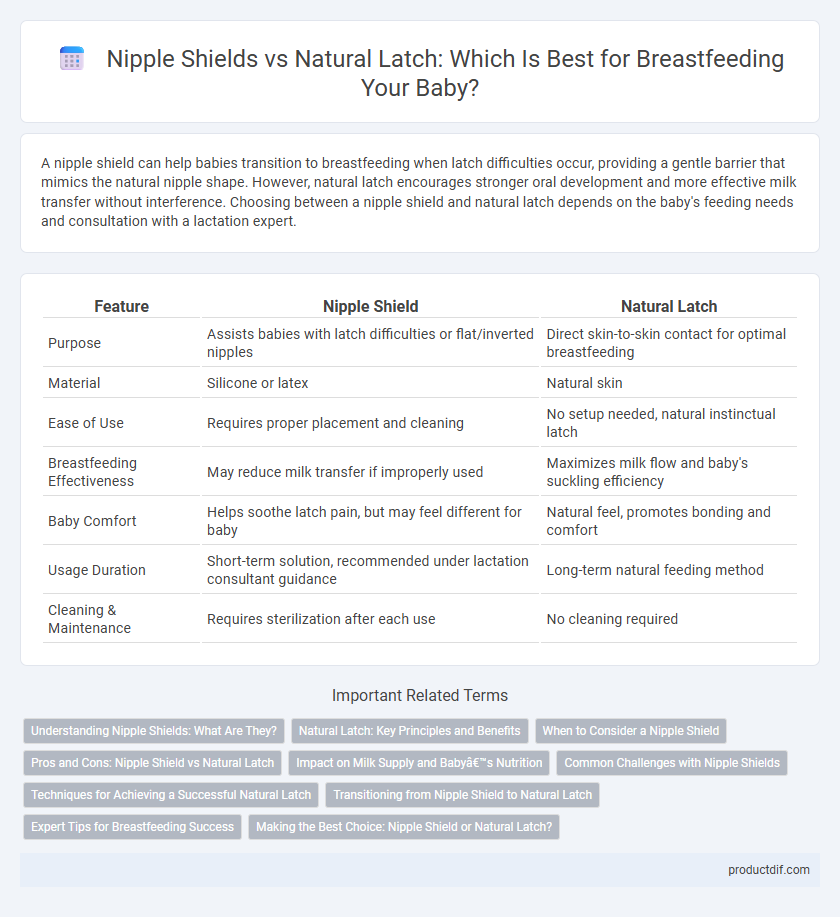A nipple shield can help babies transition to breastfeeding when latch difficulties occur, providing a gentle barrier that mimics the natural nipple shape. However, natural latch encourages stronger oral development and more effective milk transfer without interference. Choosing between a nipple shield and natural latch depends on the baby's feeding needs and consultation with a lactation expert.
Table of Comparison
| Feature | Nipple Shield | Natural Latch |
|---|---|---|
| Purpose | Assists babies with latch difficulties or flat/inverted nipples | Direct skin-to-skin contact for optimal breastfeeding |
| Material | Silicone or latex | Natural skin |
| Ease of Use | Requires proper placement and cleaning | No setup needed, natural instinctual latch |
| Breastfeeding Effectiveness | May reduce milk transfer if improperly used | Maximizes milk flow and baby's suckling efficiency |
| Baby Comfort | Helps soothe latch pain, but may feel different for baby | Natural feel, promotes bonding and comfort |
| Usage Duration | Short-term solution, recommended under lactation consultant guidance | Long-term natural feeding method |
| Cleaning & Maintenance | Requires sterilization after each use | No cleaning required |
Understanding Nipple Shields: What Are They?
Nipple shields are thin, flexible silicone covers designed to assist breastfeeding by easing latch difficulties and protecting sensitive nipples. Unlike a natural latch where the baby directly grasps the nipple and areola, nipple shields provide a barrier that can help babies with shallow latches or premature infants. Proper use of nipple shields under the guidance of a lactation consultant can support breastfeeding while ensuring effective milk transfer and nipple health.
Natural Latch: Key Principles and Benefits
Natural latch encourages an open mouth approach, allowing the baby to achieve a deep latch that promotes efficient milk transfer and reduces nipple pain. Maintaining skin-to-skin contact during feeding supports the baby's rooting reflex, enhancing their ability to self-attach correctly. Benefits include improved oral development, stronger jaw muscles, and a reduced risk of nipple damage and breastfeeding complications.
When to Consider a Nipple Shield
Consider using a nipple shield when the baby has difficulty latching due to flat or inverted nipples, or during pain caused by breastfeeding conditions like cracked nipples or thrush. Nipple shields provide a temporary aid to establish feeding while protecting sore nipples and promoting milk transfer. Consulting a lactation specialist ensures proper use and helps transition back to a natural latch effectively.
Pros and Cons: Nipple Shield vs Natural Latch
Nipple shields provide a useful solution for babies with latch difficulties, offering benefits like protecting sore nipples and facilitating breastfeeding for premature infants. However, prolonged use may lead to reduced milk transfer and interfere with establishing a natural latch, potentially causing nipple confusion. Natural latch promotes effective milk flow and bonding, but challenges such as nipple pain and infant tongue-tie can complicate the breastfeeding process.
Impact on Milk Supply and Baby’s Nutrition
Nipple shields can help improve latch difficulties but may reduce milk transfer, potentially impacting milk supply and baby's nutrition if used improperly or long-term. Natural latch encourages effective milk extraction and promotes robust milk production, enhancing the baby's nutrient intake and overall breastfeeding success. Monitoring baby's weight gain and milk output is crucial when using nipple shields to ensure adequate nutrition and supply maintenance.
Common Challenges with Nipple Shields
Nipple shields often present challenges such as improper sizing, which can hinder effective milk transfer and cause nipple pain or irritation. Mothers may experience difficulties maintaining a secure latch due to the shield's barrier, leading to reduced milk intake and potential feeding frustration. Prolonged use of nipple shields can also decrease nipple stimulation, impacting milk supply and natural breastfeeding rhythms.
Techniques for Achieving a Successful Natural Latch
Achieving a successful natural latch requires proper positioning, where the baby's mouth covers both the nipple and a significant portion of the areola, promoting effective milk transfer and minimizing nipple pain. Techniques such as supporting the baby's neck and shoulders, encouraging a wide-open mouth with a gentle touch on the upper lip, and ensuring the baby's chin touches the breast help establish a deep latch. Consistent practice and patience, along with guidance from lactation consultants, can significantly improve latch effectiveness and breastfeeding comfort.
Transitioning from Nipple Shield to Natural Latch
Transitioning from a nipple shield to a natural latch requires patience and consistent practice to help babies adapt to direct breastfeeding. Experts recommend gradually reducing shield use while encouraging skin-to-skin contact and optimal positioning to support effective latch development. Monitoring the baby's weight gain and feeding cues ensures successful transition and continued nutrition.
Expert Tips for Breastfeeding Success
Using a nipple shield can provide temporary relief for breastfeeding challenges such as latch difficulties or nipple pain while maintaining the skin-to-skin contact essential for baby's development. Experts recommend ensuring the shield is properly sized and used only under guidance to support a natural latch transition and promote effective milk transfer. Consistent practice and consulting lactation specialists help mothers achieve successful breastfeeding outcomes while addressing individual needs.
Making the Best Choice: Nipple Shield or Natural Latch?
Choosing between a nipple shield and a natural latch depends on the baby's latch effectiveness and maternal comfort during breastfeeding. Nipple shields can provide a temporary solution for infants with difficulty latching due to flat or inverted nipples, but prolonged use may affect milk supply and baby's ability to maintain a strong latch. Prioritizing consultation with a lactation specialist ensures the best approach, balancing natural feeding benefits and necessary support tools.
Nipple shield vs natural latch Infographic

 productdif.com
productdif.com